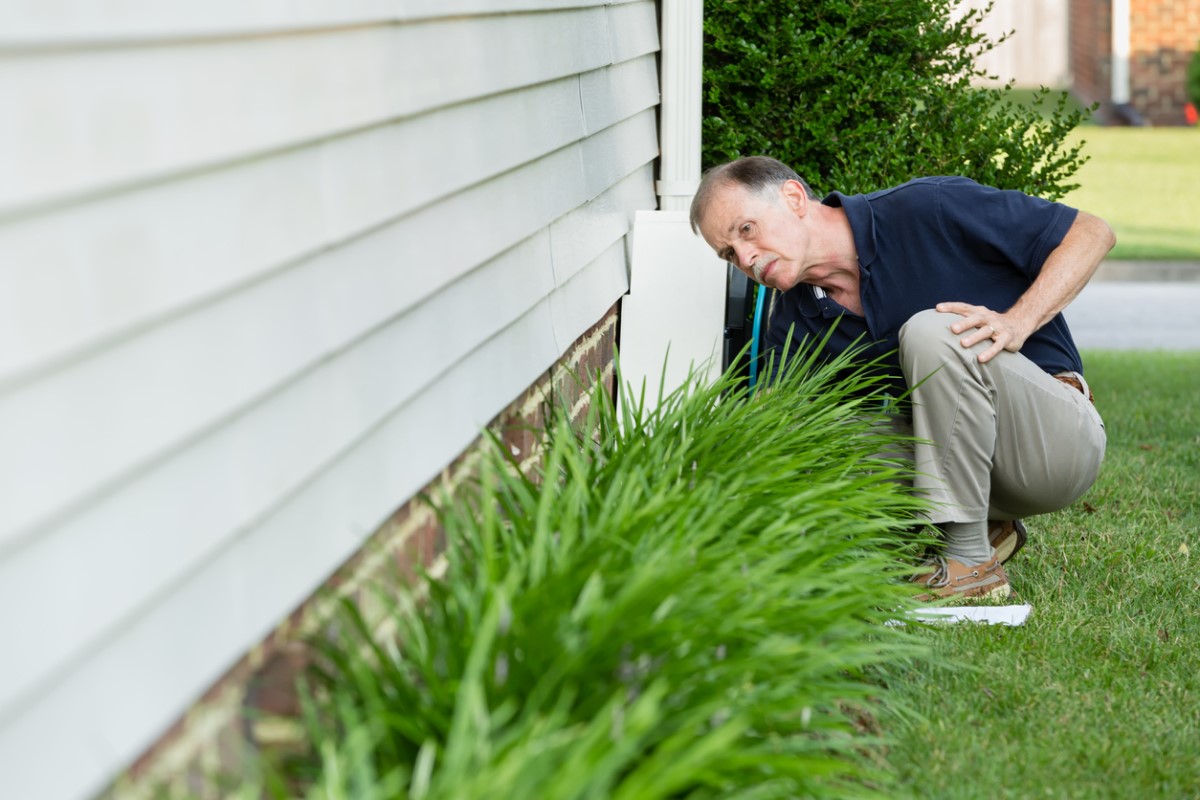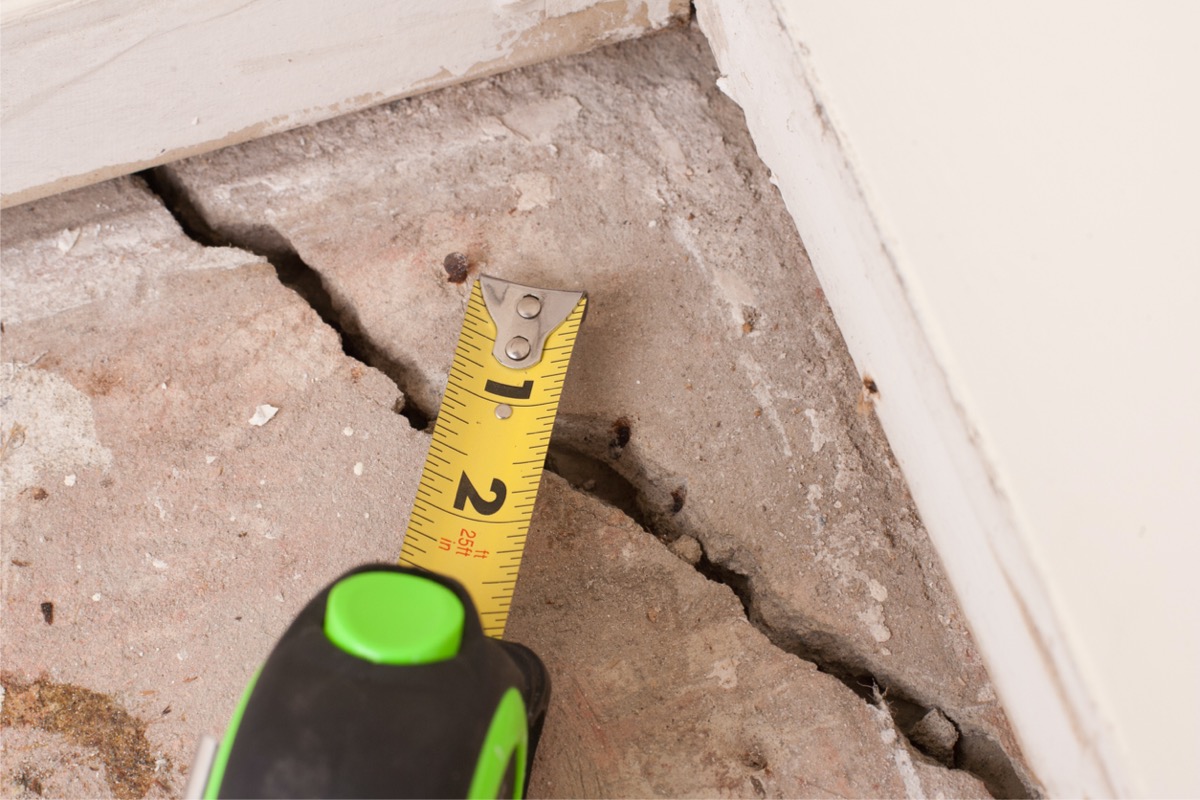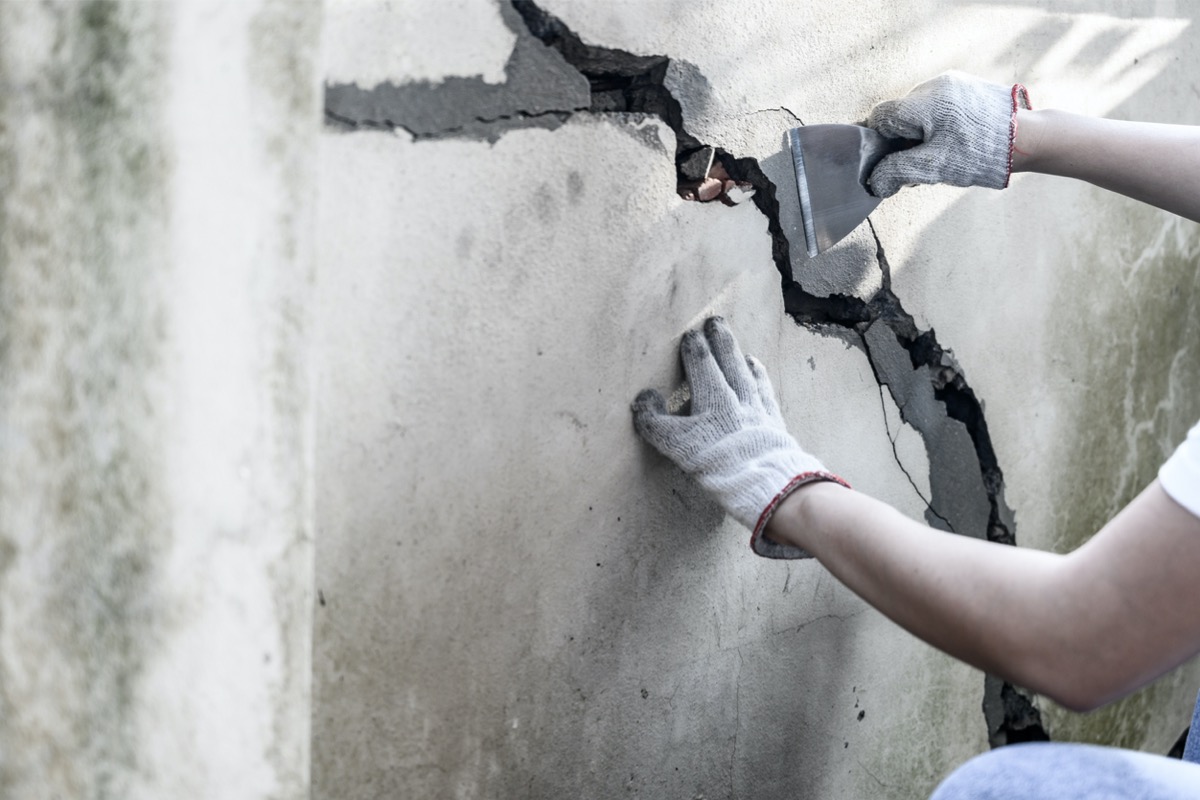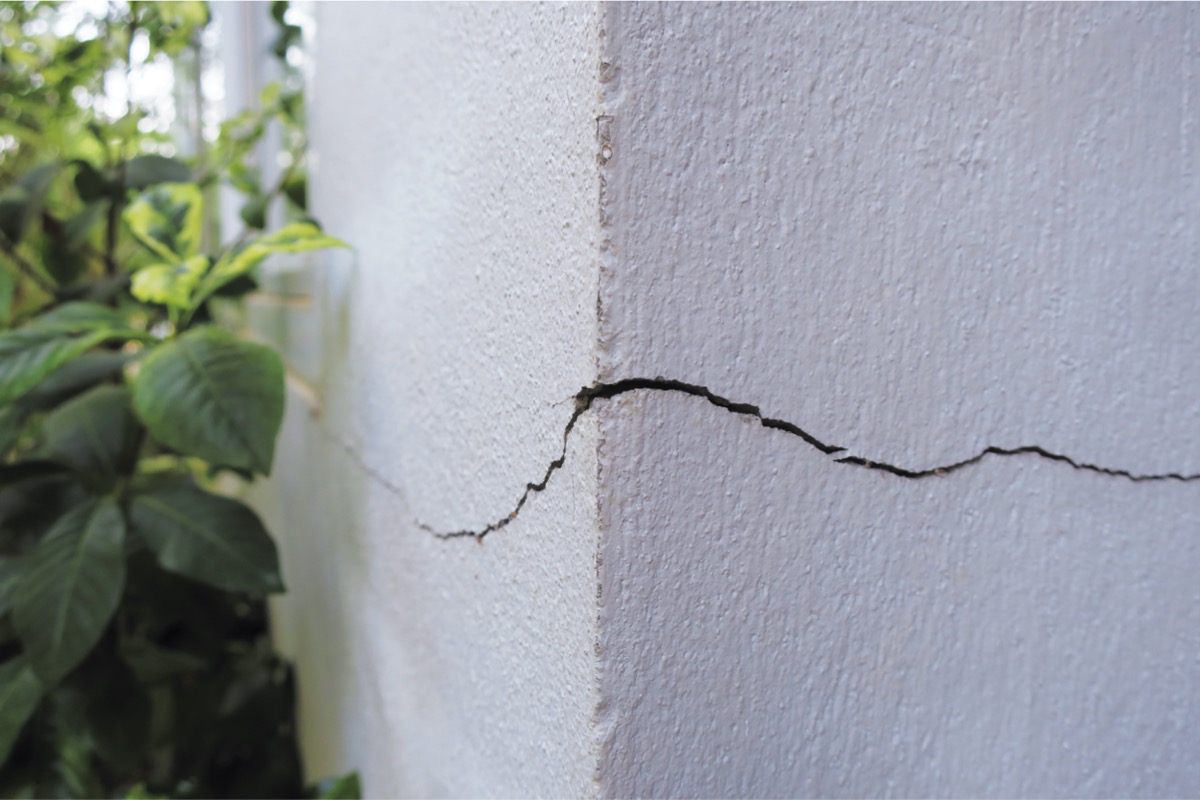

We may earn revenue from the products available on this page and participate in affiliate programs. Learn More ›
Your home’s foundation—the concrete walls surrounding a basement or crawl space—supports the entire weight of the house, so it’s natural to be concerned if you discover cracks in the concrete. Fortunately, many foundation cracks are not serious enough to warrant professional attention, and repairing a foundation crack can be a DIY task as long as the crack doesn’t threaten structural integrity.
The best way to ensure that a crack isn’t a sign of a major structural issue is to have a foundation contractor or structural engineer take a look at it. But there are some rules of thumb to keep in mind to help you decide whether or not you should worry. So, see where your crack falls on the range of foundation crack repair scenarios and find out what you can do.

Stop Foundation Damage Before It Gets Worse
Groundworks expert team can fix foundation issues before they become costly. Schedule Free InspectionIf you find hairline cracks in your foundation, don’t sweat it.
Within a year after construction, hairline cracks (about the width of a sewing thread) commonly appear on the inside of basement walls, most often near windows and doors or in the corners of the basement. This is due to normal “settling,” or the concrete shrinking slightly as it cures.
As long as the cracks are hairline in width, there’s nothing to worry about. Fixing settlement cracks of this variety is as simple as applying a coat of paint suitable for masonry, such as INSL-X TuffCrete Acrylic Concrete Paint.
If a narrow crack is new, monitor it for expansion before reaching for the crack sealer.
When you notice a new crack that’s not a hairline but still no wider than ⅛ inch, it’s probably due to settling and most likely it doesn’t present a problem—unless it continues to expand. To monitor a crack, make a pencil mark at both ends and write the date by each mark or line up a tape measure next to the crack and snap a photo. In addition, measure the width at the widest point and write that on the wall or make a note on the photo.
Check the crack at least monthly for several months and make additional marks and record dates if the crack expands. If no expansion occurs and no moisture seeps through, the crack is stable and you can fill it with grout, such as Sashco Gray Mor-Flexx Grout Repair, and then smooth it out with a putty knife.
Professional foundation repair can provide long-lasting protection in ways that many DIY fixes can’t. An expert inspector will be able to identify the root cause of the cracking and treat it properly with a number of solutions depending on the severity of the issue. Wall braces, wall anchors, and carbon fiber support strips can all be used to push back against bowing walls and prevent further cracking.
— Tim Tracy, regional manager for Groundworks

If the crack is wider than ⅛ inch, seal it with concrete crack filler.
Cracks between ⅛ and ¼ of an inch often result from house settling or concrete shrinking within a few months after construction, and so may pose no structural problem. But it’s a good idea to seal them to keep out moisture, soil smells, or even radon gas.
Repairing a foundation crack in this width range is a simple DIY project that involves filling the crack with a caulk that’s compatible with concrete, such as Dap Concrete and Mortar Sealant.
If a horizontal crack appears where the foundation wall meets the basement floor, it’s not a structural problem—but it should be sealed.
Because basement floors are poured after the walls are poured, the concrete where they meet doesn’t always bond completely—and this is a common spot for a crack to appear when the house settles. The crack can be up to ½ inch wide and still not pose a problem other than letting in moisture, smells, and gasses. Repair a foundation crack like this as you would repair other nonstructural cracks: By filling it with a caulk suitable for use on concrete.
You can also find concrete crack repair kits with all of the tools needed to seal the crack. If a crack between the wall and floor exceeds ½ inch (some can be 2 inches wide or more), call a foundation contractor who can fill it by injecting an expanding epoxy. If you have a crack like this to deal with, certainly don’t finish the basement before making the repair.
Foundation leak repair is more expensive than concrete crack repair, so act fast if you notice water seeping through a foundation crack.
If water is seeping through a crack, seal the crack and divert the water. Basements and crawl spaces are normally damp because they’re located below grade (yard level). But when water—not just moisture—actually seeps through a crack, it poses an increased risk of mold and mildew growth.
While the crack should be sealed as described above, it’s even more important to keep water away from the foundation wall. This can be done by removing foundation plantings, installing guttering and downspouts, and adding soil to the yard along the foundation to create a 2 percent or more slope away from the house that allows water to naturally run away from the foundation.
While leaks are a concern when it comes to foundation cracks, they’re far from the only potential issue. Pests can make their way into the home through even minor cracks, and the lack of a tight seal can also compromise the insulation of the home by allowing hot, cold, or damp air into the space.
— Tim Tracy, regional manager for Groundworks
If you have a cracked foundation and the gap is more than ½ inch wide, have a pro take a look.
Although many larger foundation cracks may still turn out to be harmless, it’s a good idea to have a foundation contractor or a structural engineer inspect the foundation to check for structural problems.
Repairing a foundation crack that is more than ½ inch wide may well be a DIY task with a foundation crack repair kit, but on the off chance that the crack is due to something more serious, a professional opinion should be sought first.

Stop Foundation Damage Before It Gets Worse
Groundworks expert team can fix foundation issues before they become costly. Schedule Free Inspection
If a large crack accompanies a bulge in a foundation wall, it indicates a structural problem.
Foundation walls are reinforced with steel to keep them from moving. In areas with clay soil, the clay can swell when it becomes wet and put intense lateral (hydrostatic) pressure on the wall, pushing it inward and leading to structural cracks that may indicate bigger issues. This is a major problem, and a foundation contractor should be consulted.
If the bulge is slight, it might be difficult to see, but you can hold a long straightedge, such as a 6-foot level, along the wall to determine whether the area with the crack is bulging. Even a slight bulge that accompanies a crack is cause for concern and a pro should take a look.
Horizontal cracks are more likely to indicate trouble than diagonal and vertical foundation cracks.
While any crack can be unsightly, diagonal and vertical foundation cracks are usually the result of normal settling, and they can be treated as directed above. Like bulging walls, horizontal cracks are typically caused by hydrostatic pressure, and even if the wall isn’t bulging, it’s time to call in the pros.
Stabilizing a foundation with structural problems can involve a number of different remedies, including excavation around the outside of the wall, hydraulic lifting, or underpinning the wall with steel, but only a foundation contractor will be able to assess the extent of the problem and offer a suitable remedy.
RELATED: 10 Ways to Know Whether You Should Repair a Foundation Crack
Foundation cracks that change direction may indicate serious structural damage.
While a hairline crack or a crack that hasn’t changed in a long time isn’t usually something to worry about, cracks that change direction or follow mortar joints in a stair-step pattern need to be addressed. This pattern of crack can indicate that the soil is moving beneath and around the home, putting changing amounts of pressure on the foundation and causing the foundation to move in ways it wasn’t designed to.
Don’t ignore this type of foundation crack. An engineer can drill for soil samples and perform soil tests to figure out what’s happening and how the situation can be fixed.

Epoxy injection is one of the best methods for fixing cracks in concrete foundations.
Usually used to fix cracked concrete after event damage from an earthquake or an impact— situations where movement is no longer present—epoxy injections can be effective at fixing foundation cracks.
This epoxy, however, isn’t exactly the same as the handy two-part epoxy used for crafts and other household repairs. This epoxy is delivered as a pressurized injection and usually comes with injection ports like this one from PC Products to make it easy to deliver the epoxy into the crack. First, the crack is cleaned, dried, and then blown with compressed air to make sure it’s free of any debris. Then the injection fitting is set up and the epoxy is injected into the crack until it’s full.
If the crack is damp and it’s impossible to make it dry, consult with a professional. They may be able to use a polyurethane injection in the same manner as an epoxy injection to seal the crack.
Uneven floors are a common sign of foundation cracks or other issues, and they can be observed throughout the home. Some other things to look out for could be drywall cracks, especially around doors or windows, as well as any doors or windows that start to stick.
— Tim Tracy, regional manager for Groundworks
Remember these important things you can do to prevent foundation cracks in the first place.
Here is the good news: Some foundation cracks can be prevented. While we can’t control all of the effects of Mother Nature, there are a number of simple preventive methods that do work and are worth the effort. Unfortunately, the list of ways to prevent cracks includes chores many homeowners don’t exactly enjoy.
Not surprisingly, many of the best ways to prevent foundation cracks involve keeping water away from the house. Make sure to keep drains, gutters, and downspouts clear of debris so water can’t pool near the foundation. If water tends to collect around the foundation during and after rainstorms even when your gutters and drains are clear, consider a landscaping makeover to regrade the yard and to keep plant roots away from the foundation. And to make sure little problems don’t balloon into major headaches, always keep track of and repair small cracks as soon as you notice them.
